Gamma rays given off by fourteen different sources in our sky could be a sign of the existence of antistars, leading to the potential for breaking the standard cosmological model. Plus, nano dust, the HI-SEAS experiment, hydroxyl at an exoplanet, and this week’s What’s Up.
Media
Transcript
Hello and welcome to the Daily Space. I am your host Dr. Pamela Gay.
And I am your host Beth Johnson.
And we are here to put science in your brain.
As much as we enjoy studying the skies strictly for scientific reasons, sometimes it turns out there are less inspirational reasons like making sure our planet doesn’t get destroyed by incoming asteroids. Our solar system is filled with rocks, and while we’d like to think we found all the large ones, the truth is there are probably some space rocks capable of ending humanity still not discovered, and there are definitely objects big enough to destroy cities still missing from our catalogs.
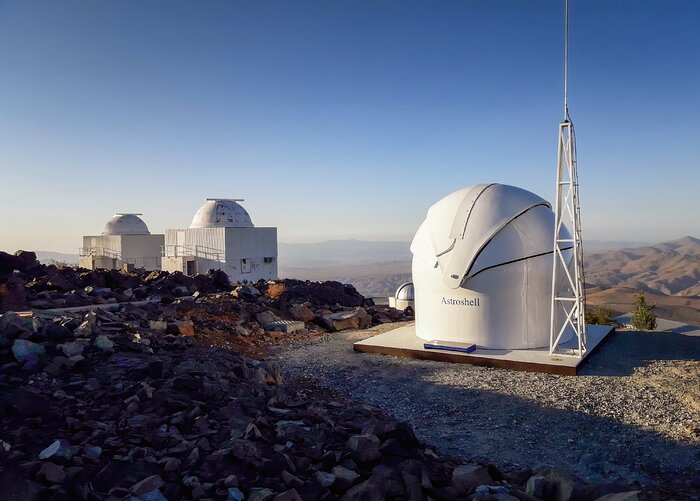
To fill in these gaps in our maps, a number of telescopes are regularly monitoring the sky. Here in the northern hemisphere, we are pretty full up on surveys, but in the southern hemisphere, there have been gaps in the coverage; gaps a new telescope in Chile hopes to fill in.
The European Southern Observatory and the European Space Agency have jointly completed the construction of a new 56-centimeter telescope that is a twin to an existing telescope in Spain. Together, these scopes are testing new technologies that may be deployed in a future “Flyeye” telescope network designed to track fast-moving objects in the sky.
These kinds of systems are particularly good at providing early warnings for incoming smaller bodies, like the meteor that struck in Botswana that we discussed last week and the 2013 Chelyabinsk meteor event. Since the Earth’s surface is mostly water, we don’t actually know how common those kinds of events are, and I both dread and am excited by the prospect of these scopes discovering a lot of space rocks hitting Earth in harmless places.
Asteroids and fallen smaller meteorites are responsible for a lot of different things in our solar system. For instance, moondust. Space rocks striking the surface of the Moon have pulverized their surface into sharp dust that ranges in size down to nano-particles capable of irritating skin and damaging lungs.

When not irritating astronauts, these tiny fragments are also responsible for giving the Moon its colors and defining how much light it reflects. In a new journal article in IEEE Xplore with first author Somen Baidya, researchers discuss how they used tiny X-ray wavelengths of light to examine the shape of particles just 400 nanometers across. Several hundred of these particles could fit across the diameter of a human hair!
Just measuring these grains is remarkable. According to researcher Ed Garboczi: Since they are so tiny and because they only come in powders, a single particle needs to be separated from all the others. They are too small to do that by hand, at least not in any quantity, so they must be carefully dispersed in a medium. The medium must also freeze their mechanical motion, in order to be able to get good XCT images. If there is any movement of the particles during the several hours of the XCT scan, then the images will be badly blurred and generally not usable. The final form of the sample must also be compatible with getting the X-ray source and camera close to the sample while it rotates, so a narrow, straight cylinder is best.
Basically, they made fancy moondust popsicles, looked at them with X-rays, and got remarkable images of the dust grains’ shapes. Those shapes, depending on how round or elongated they are, give the Moon its colors. This final “what does each shape mean” work is ongoing. Today, we just want to celebrate that they measured the shapes. And if you’re into fancy high-tech imaging setups, now we are celebrating the spirit of the tinkerer.
According to the release: The procedure involved stirring the Apollo 11 material into epoxy, which was then dripped over the outside of a tiny straw to get a thin layer. Small pieces of this layer were then removed from the straw and mounted on dressmakers’ pins, which were inserted into the XCT instrument.
As NASA plans to go back to the Moon and eventually journey to Mars, a lot of energy is going into most dust mitigation so that tiny, sharp dust stays away from humans, and into figuring out how to build suits that allow astronauts to explore safely and easily. One of our big concerns with Mars is radiation, and one of the best ways to escape radiation is to live and work inside a lava tube.
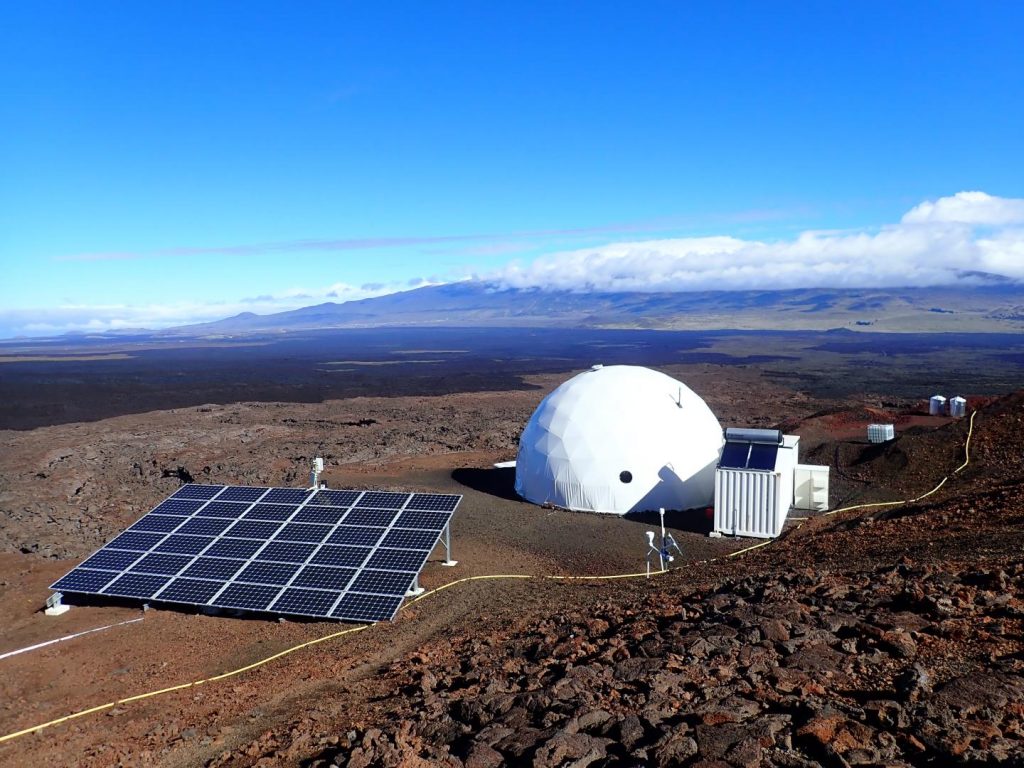
To this end, researchers have donned spacesuits to explore Hawaiian lava tubes to figure out what is and isn’t possible and what problems need to be solved. This research is being presented at the European Geosciences Union’s meeting this week by Bernard Foing. According to researcher Michaela Musilova: Doing research in suits under EVA constraints makes everything much more difficult to do, and it all takes three times longer. We need to train extensively on Earth to figure out the best methods and create the best EVA suits so that we’ll be able to perform this kind of research on the moon and Mars one day.
This is your reminder that for every great accomplishment off the Earth, there have been countless hours of development, testing, and training here on Earth, both in giant pools and in high desert environments; testing and training done by folks whose names are rarely mentioned, and whose faces are hidden in these amazing helmets.
When you study astronomy, and people learn that you study astronomy, you get asked lots of questions along the lines of “Could there be antimatter stars?”, “Could there be antimatter galaxies?”, and “Could there be dark matter galaxies?” And while we think we have found galaxies made of dark matter, most of my colleagues have gone through life saying “No, there are not antimatter stars.” And we might be wrong.
This is why we do science. We want to figure out what is real about the universe, and we recognize that we actually don’t know everything; we are just trying really hard to know everything.
Now, there are two kinds of matter, and we’re really bad at naming things. So there is the stuff we’re made out of – electrons, neutrons, protons, regular matter. But all of these particles have an antimatter version. Neutrinos have an antimatter version. And if you’ve watched Star Trek, you know that controlled reactions with antimatter generate a ton of energy. This is because if you put a regular electron and its antimatter cohort – a position or antielectron – together they are going to combine into energy. It’s awesome and luckily doesn’t happen all the time. For the most part, when particles come together, the reactions aren’t right to release energy. Antimatter neutrinos are passing through you constantly. No big deal.
For reasons we don’t know, our universe probably formed with equal amounts of matter and the oppositely charged but otherwise identical “has gravity working the same way, has mass working in the way” antimatter. It’s just that charge that is different. The universe probably formed with equal amounts of matter and antimatter, and then something went sideways, and we were left with a universe that is pretty much all matter. We thought that meant no antimatter stars.
A group of astronomers has gone through the Fermi Gamma-ray Space Telescope’s data and discovered fourteen different flickering spots in the sky that give off flashes of gamma-ray light that is consistent with those fourteen sources being antimatter stars. How did this happen? No idea. Is this what actually happened? No idea. This is one of those times when you look at something, there are a variety of options, and one of them defies all expectations. So those fourteen flickers are consistent with antimatter stars.
That means that somehow our universe had clumps of antimatter that survived in the midst of all the matter or managed to form later. Those clumps of antimatter collapsed down into stars and because matter and antimatter look identical in how they do fission and fusion and all those sorts of things, those stars would be shining just like any other star except when a bit of actual matter hits them just right… gamma-rays happen.
Now, normally I would simply look at this research and say, “Huh. That’s cool.” And then set it aside. The reason I didn’t entirely do that today is that an experiment aboard the International Space Station captured evidence of random antimatter helium just kinda hanging out existing as helium atoms do, except it was antimatter helium. Antimatter. Helium. And the best way to explain that is if there are antimatter stars.
Again, this could have an entirely different explanation. We do science to figure these things out, but the universe just keeps showing us that it is more creative than we are in coming up with theories. So we have two lines of evidence: random antimatter helium detected by the ISS experiment and fourteen sources of flickering light.
If there are antimatter stars out there they probably aren’t common, or we’d see a whole lot more flickering. Based on the density of the kind of material that is hanging around and then would be hitting these antimatter stars, if they exist in the disk of our Milky Way, they’d only be one in every 400,000 stars. Because there is so much stuff floating hitting around that would be hitting them, they would be twinkling like Christmas lights but in gamma-rays. If however, they are super rare and they only exist in the outskirts, the halo of the galaxy, there could be as many as one in ten stars out there that are antimatter, and we just don’t see them because there is not a lot of stuff hitting them causing them to flicker.
I’m still not saying we found them. I’m saying there is some cool stuff going on that we don’t understand, and one really weird explanation that I would never have expected to see is that there are antimatter stars. This work is published in Physical Review D by Simon Dupourqué, Luigi Tibaldo, and Peter von Ballmoos.
We’re going to follow this story, folks. I don’t know where it’s going to go, but that’s going to happen on another day.

It seems astronomers are always searching for something new, something special, something groundbreaking that will lead us onto the next big discovery. And while antistars are incredibly fascinating, and I hope we discover them, I’ll be over here, watching as our ability to detect certain particles in the atmospheres of exoplanets continues to grow. In a recent paper in The Astrophysical Journal Letters, an international team of astronomers reports on finding hydroxyl — that tiny molecule consisting of one hydrogen atom and one oxygen atom — in the atmosphere of super-hot Jupiter WASP-33b.
Now, when I say super-hot, I mean that because this planet orbits its star at a distance closer than that of Mercury to our own Sun, atmospheric temps reach more than 2500˚ Celsius. That’s hot enough to melt most metals, y’all.
Finding hydroxyl on a hot Jupiter isn’t just exciting for the discovery itself, but also for the upgrade in technology that allowed the team to make the discovery. A new instrument at the Subaru Telescope in Hawai’i called the InfraRed Doppler uses absorption spectroscopy — dark lines breaking up a full rainbow of light — to detect the fingerprint of various molecules. The instrument works by using the Doppler shift of the light as the planet’s velocity changes, relative to Earth, while it orbits its host star. Basically, we can use those changes in velocity to separate the planet’s characteristics from the star’s, since the star’s velocity doesn’t change, again, relative to Earth. And then we match the dark lines with the known patterns of a variety of atoms and molecules to figure out what is in the atmosphere.
Hydroxyl is an important molecule to find. Here on Earth, it’s produced by the reaction of water vapor with atomic oxygen and is considered an ‘atmospheric detergent’ because it reacts with polluting gas like methane and carbon dioxide to essentially remove them. In the case of WASP-33b, the hydroxyl is produced by the destruction of the water vapor under the high heat of the star. And confirm the likelihood of this explanation is the very weak signal of water vapor in the data.
But why bother with hot Jupiters? As co-author Dr. Neale Gibson states: The science of extrasolar planets is relatively new, and a key goal of modern astronomy is to explore these planets’ atmospheres in detail and eventually to search for ‘Earth-like’ exoplanets – planets like our own. Every new atmospheric species discovered further improves our understanding of exoplanets and the techniques required to study their atmospheres and takes us closer to this goal.
And co-author Chris Watson adds: While WASP-33b may be a giant planet, these observations are the testbed for the next-generation facilities like the Thirty Meter Telescope and the European Extremely Large Telescope in searching for biosignatures on smaller and potentially rocky worlds, which might provide hints to one of the oldest questions of humankind, ‘Are we alone?’
What’s Up
‘Tis the season for galaxy observing. Or at least for observing our galaxy, from edge to edge to core, as the world rotates. If you live in a particularly dark area, you can now go out and, once that Sun has fully set below the horizon and no more twilight is left, you’ll be able to make out that creamy band sprawling across the sky. We’re going to have finding charts up on our website Dailyspace.org to help you find this.

One of the really cool things about this particular time of year is that, if you got out after evening twilight, you’re going to be seeing the part of the Milky Way that points straight out from the center of the galaxy. And as our world turns and allows us to see more and more of our galaxy, it’s going to rotate you around until, just before dawn, that band appears to bloat up into a much wider bulge that happens to be the bulge of our galaxy located in the Sagittarius constellation.
Now, living inside of a disk means we’re surrounded by dust and stars and gas, and we can’t actually look out at the universe beyond. We can only see a set distance into all of that stuff. This means we couldn’t actually figure out how far we are from the center of the galaxy by looking through the galaxy. We had to instead lookout in all other directions and look for the locations of globular clusters. Since we know that globular clusters pretty much form a sphere around the Milky way, we were able to use their distribution to figure out our place in space.
There is still a lot to learn about our galaxy, and in a new paper in the journal Nature, researchers discuss an imaging campaign led by Charlie Conroy that studied the effects of the Large Magellanic Cloud on the galaxy’s halo and dark matter constituents. It has long been thought that this small galaxy and its visible and dark matter should leave a wake in our galaxy’s visible and dark matter constituents, and for the first time, that wake has been seen.
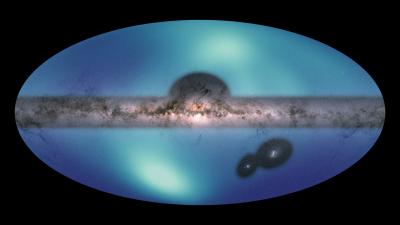
This work is in its early days, but by understanding how the Large Magellanic Cloud disturbs the Milky Way’s dark matter halo, we can start to understand the properties of the dark matter. Think of it this way: the wake of a boat varies depending on if the boat sails in water or glycerin, and, folks, this was a lab I did with model boats and undergrads back in the day.
It’s a really special set of circumstances that came together to create this scenario that lets us test our dark matter theories, said Gurtina Besla, a co-author of the study. I can’t wait to see what they learn from this wake they have discovered.
Those stories are for a future episode.
For now, this has been the Daily Space.
Learn More
New Telescope to Help With Risky Asteroid Detection
- ESO press release
Measuring the Moon’s Nano Dust Particles
- NIST press release
- “Optical Scattering Characteristics of 3-D Lunar Regolith Particles Measured Using X-Ray Nano Computed Tomography,” Somen Baidya et al., 2021 April 27, IEEE Geoscience and Remote Sensing Letters
HI-SEAS Habitat in Hawai’i Tests EVA Suits in Lava Tubes
- EGU press release
- “Simulating lava tube exploration research during analog lunar and Martian missions at HI-SEAS in Hawaii,” Michaela Musilova, Bernard Foing, and Henk Rogers, 2021 April 19-30, EGU General Assembly 2021
Signs of Possible Antistars Found in Fermi Data
- IRAP press release
- “Constraints on the antistar fraction in the Solar System neighborhood from the 10-year Fermi Large Area Telescope gamma-ray source catalog,” Simon Dupourqué, Luigi Tibaldo, and Peter von Ballmoos, 2021 April 20, Physical Review D
Hydroxyl Found in Exoplanet Atmosphere For First Time
- Astrobiology Center press release
- Trinity College press release
- Queen’s University Belfast press release
- “First Detection of Hydroxyl Radical Emission from an Exoplanet Atmosphere: High-dispersion Characterization of WASP-33b Using Subaru/IRD,” Stevanus K. Nugroho et al., 2021 March 23, The Astrophysical Journal Letters
What’s Up: Milky Way Season Begins
- How to see the Milky Way (Sky at Night)
- Milky Way season has started! (EarthSky.org)
New All-Sky Map of Milky Way Released
- Center for Astrophysics press release
- “All-sky dynamical response of the Galactic halo to the Large Magellanic Cloud,” Charlie Conroy et al., 2021 April 21, Nature
Credits
Written by Pamela Gay and Beth Johnson
Hosted by Pamela Gay and Beth Johnson
Audio and Video Editing by Ally Pelphrey
Content Editing by Beth Johnson
Intro and Outro music by Kevin MacLeod, https://incompetech.com/music/


 We record most shows live, on Twitch. Follow us today to get alerts when we go live.
We record most shows live, on Twitch. Follow us today to get alerts when we go live.